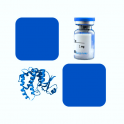
- Remove this product from my favorite's list.
- Add this product to my list of favorites.
Products
Viewed products
Newsletter
 |  |  |  |  |  |

Background
Fas ligand also known as FasL, CD178, CD95L, or TNFSF6, is a homotrimeric type-II transmembrane protein that belongs to the tumor necrosis factor (TNF) family. Its binding with its receptor induces apoptosis. Fas ligand/receptor interactions play an important role in the regulation of the immune system and the progression of cancer. Mature human Fas Ligand consists of a 179 amino acid (aa) extracellular domain (ECD), a 22 aa transmembrane segment, and a 80 aa cytoplasmic domain. Within the ECD, human Fas Ligand shares 81% and 78% aa sequence identity with mouse and rat Fas Ligand, respectively. Apoptosis triggered by Fas-Fas ligand binding plays a fundamental role in the regulation of the immune system. Its functions include:T-cell homeostasis, cytotoxic T-cell activity, immune privilege, maternal tolerance, tumor counterattack. Defective Fas-mediated apoptosis may lead to oncogenesis as well as drug resistance in existing tumors. Germline mutation of Fas is associated with autoimmune lymphoproliferative syndrome (ALPS), a childhood disorder of apoptosis.
Source
Recombinant Human Fas Ligand, His Tag, premium grade(FAL-H5241) is expressed from human 293 cells (HEK293). It contains AA Pro 134 - Leu 281 (Accession # AAH17502.1).
Predicted N-terminus: His
It is produced under our rigorous quality control system that incorporates a comprehensive set of tests including sterility and endotoxin tests. Product performance is carefully validated and tested for compatibility for cell culture use or any other applications in the early preclinical stage. When ready to transition into later clinical phases, we also offer a custom GMP protein service that tailors to your needs. We will work with you to customize and develop a GMP-grade product in accordance with your requests that also meets the requirements for raw and ancillary materials use in cell manufacturing of cell-based therapies.
Molecular Characterization
This protein carries a polyhistidine tag at the N-terminus.
The protein has a calculated MW of 18.8 kDa. The protein migrates as 25-33 kDa when calibrated against Star Ribbon Pre-stained Protein Marker under reducing (R) condition (SDS-PAGE) due to glycosylation.
Endotoxin
Less than 0.1 EU per μg by the LAL method.
Sterility
Negative
Mycoplasma
Negative.
Purity
>90% as determined by SDS-PAGE.
>90% as determined by SEC-MALS.
Formulation
Lyophilized from 0.22 μm filtered solution in PBS, pH7.4 with trehalose as protectant.
Reconstitution
See Certificate of Analysis for details of reconstitution instruction and specific concentration.
Storage
For long term storage, the product should be stored at lyophilized state at -20°C or lower.
Please avoid repeated freeze-thaw cycles.
This product is stable after storage at:
-20°C to -70°C for 12 months in lyophilized state;
-70°C for 3 months under sterile conditions after reconstitution.
Bioactivity
Please refer to product data sheet.
(1) "FasL impacts Tgfb signaling in osteoblastic cells"
Kratochvilova, Knopfova, Gregorkova et al
Cells Dev (2024)
(2) "Matrix metalloproteinase/Fas ligand (MMP/FasL) interaction dynamics in COVID-19: An in silico study and neuroimmune perspective"
Saleki, Aram, Alijanizadeh et al
Heliyon (2024) 10 (10), e30898
(3) "Modeling the heterogeneous apoptotic response of caspase-mediated signaling in tumor cells"
Mangrum, Finley
J Theor Biol (2024) 590, 111857
Showing 1-3 of 12635 papers.
Follow us